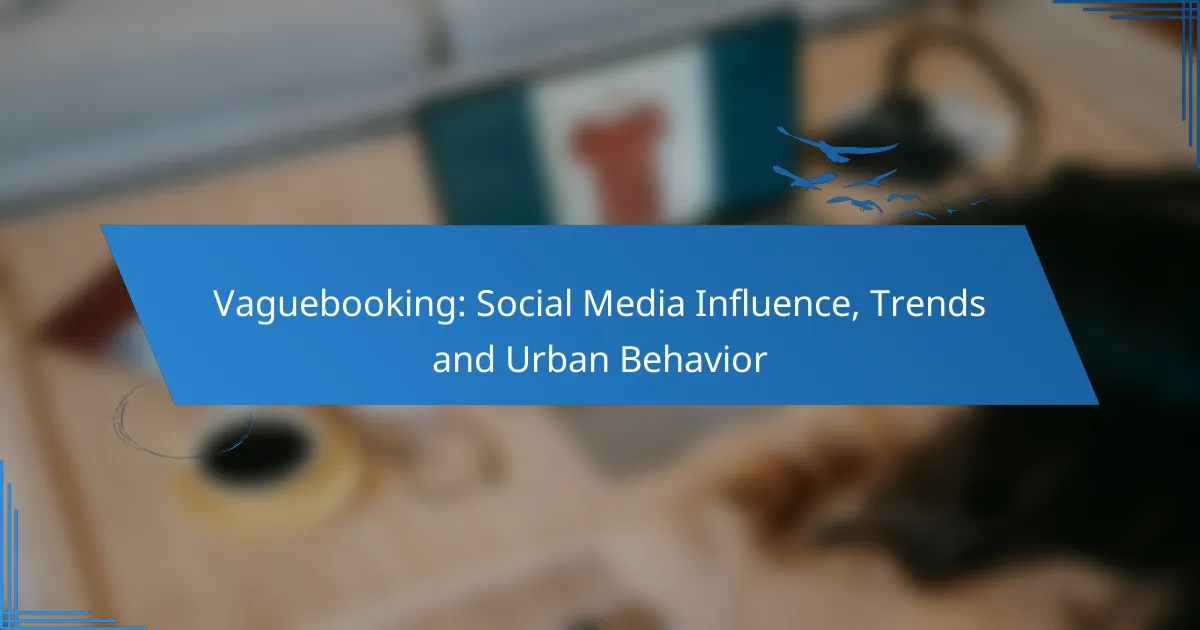Vaguebooking, the act of sharing ambiguous posts on social media, has become a notable trend in urban environments, particularly among younger users. This behavior not only enhances emotional connections but also stimulates engagement as followers seek to decipher the unclear messages. By understanding and managing vaguebooking, individuals can foster clearer communication and maintain a positive online atmosphere.
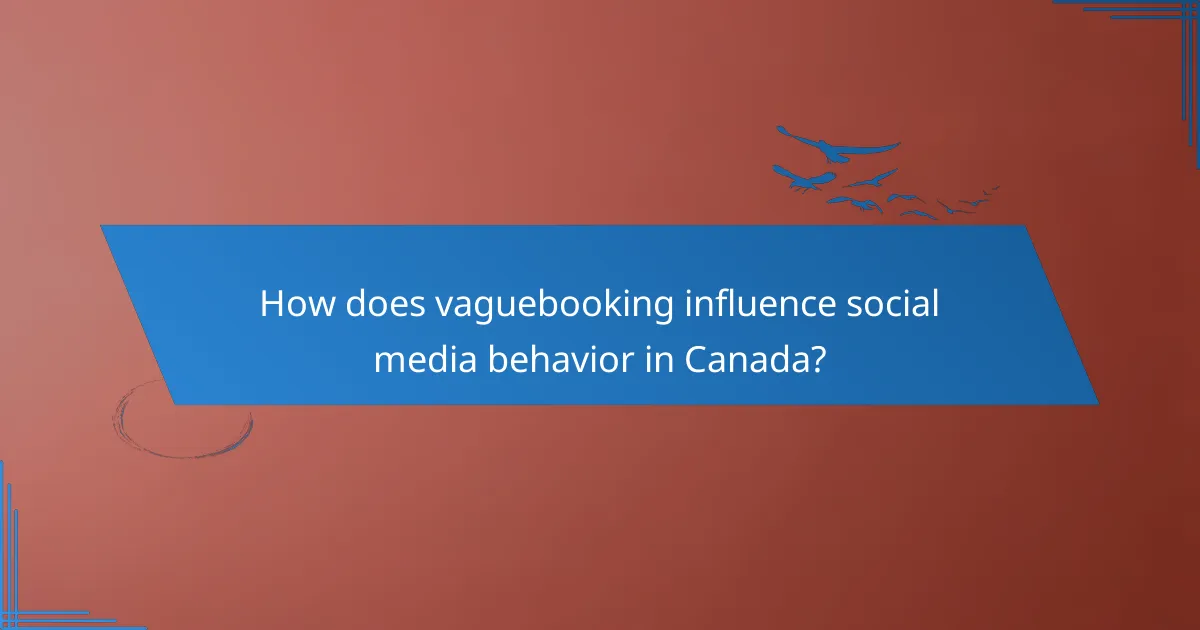
How does vaguebooking influence social media behavior in Canada?
Vaguebooking, the practice of posting ambiguous or unclear updates on social media, significantly impacts user behavior in Canada by fostering emotional connections and driving engagement. This trend often leads to increased interactions as followers seek clarification or express their support.
Increased engagement through emotional expression
Vaguebooking taps into the emotional landscape of social media, encouraging users to share feelings without disclosing full details. This approach can lead to heightened engagement, as followers respond with empathy or curiosity, often resulting in more comments and likes.
For instance, a post like “Feeling overwhelmed today” can prompt friends to reach out, creating a supportive dialogue. This emotional expression is particularly effective in Canada, where community support is valued, and users often rally around friends in need.
Encouragement of speculation among followers
Vaguebooking invites speculation, as followers attempt to decipher the meaning behind unclear posts. This guessing game can lead to increased interaction, as users comment with their interpretations or ask for more information.
A typical example might be a post stating, “Big changes are coming,” which can spark a flurry of questions and theories. This behavior not only boosts engagement but also keeps the conversation alive, making users feel more connected to the poster and each other.

What are the trends associated with vaguebooking in urban areas?
Vaguebooking trends in urban areas often reflect a desire for attention and engagement without providing clear context. This behavior is particularly prevalent among younger demographics, who use ambiguous posts to provoke curiosity and discussion.
Rise of ambiguous posts among millennials
Millennials are increasingly turning to vaguebooking as a means of expressing emotions or thoughts without full disclosure. This trend often manifests in cryptic statuses or indirect references that invite speculation from friends and followers.
For instance, a millennial might post, “Feeling lost today,” which prompts friends to inquire about their well-being. This indirect communication style fosters a sense of community while allowing individuals to maintain a level of privacy.
Impact of vaguebooking on mental health awareness
Vaguebooking can have mixed effects on mental health awareness. On one hand, it can encourage conversations about mental health issues, as friends may reach out to offer support or share their own experiences. On the other hand, the lack of clarity can lead to misunderstandings and increased anxiety for both the poster and their audience.
To navigate this, individuals should consider being more direct when discussing serious topics. Clear communication can enhance understanding and support, while vague posts may inadvertently contribute to stigma or confusion surrounding mental health issues.
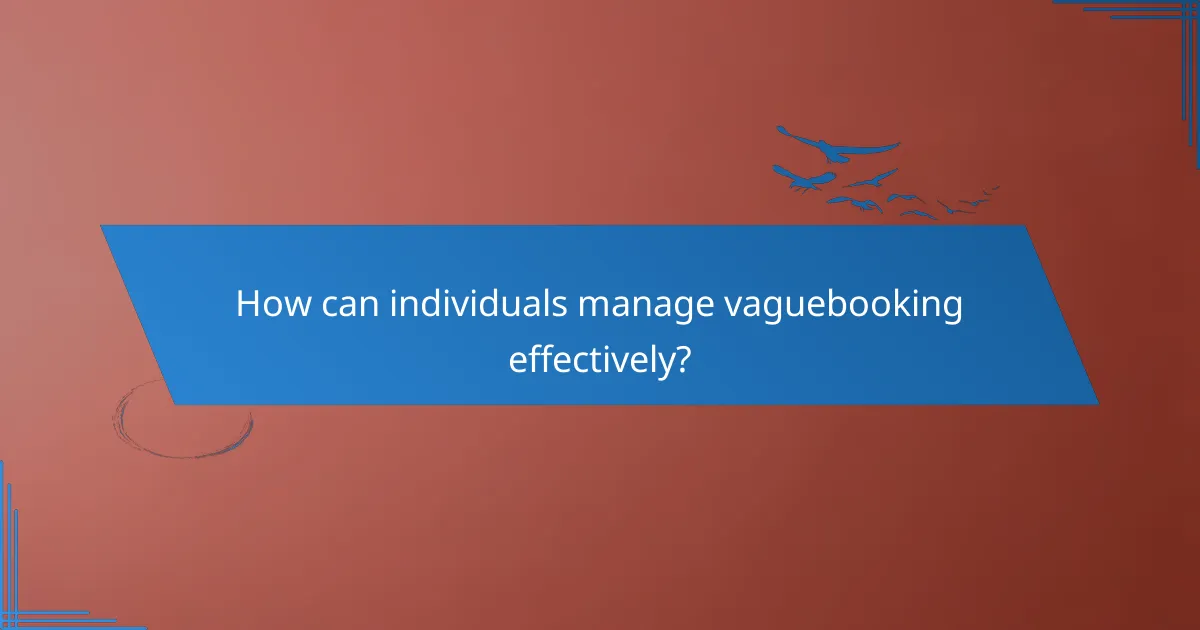
How can individuals manage vaguebooking effectively?
Individuals can manage vaguebooking by establishing clear communication practices and utilizing direct messaging for personal matters. This approach helps reduce misunderstandings and ensures that social media remains a positive space for sharing thoughts and experiences.
Setting clear communication boundaries
To effectively manage vaguebooking, it is essential to set clear communication boundaries. This involves defining what topics are appropriate for public sharing and which should remain private. For instance, consider discussing personal struggles or sensitive issues in a more private setting rather than on a public platform.
Establishing these boundaries can prevent confusion among friends and followers. A simple guideline is to ask yourself if the post adds value or clarity to your audience. If not, it may be better suited for a direct conversation.
Using direct messaging for personal issues
When dealing with personal issues, using direct messaging can be a more effective way to communicate than vague public posts. This method allows for more nuanced conversations and can help avoid unnecessary speculation from others. For example, if you’re facing a challenging situation, reach out to close friends privately instead of hinting at it online.
Direct messaging fosters a supportive environment where friends can offer help without the pressure of public scrutiny. Remember to keep your messages clear and concise to ensure your point is understood without ambiguity.

What are the psychological effects of vaguebooking?
Vaguebooking can lead to various psychological effects, primarily centered around the need for validation and increased anxiety. Individuals who engage in this behavior often seek attention or support without providing clear context, which can create a cycle of emotional responses.
Validation-seeking behavior
Vaguebooking often stems from a desire for validation, where users post ambiguous statements to elicit reactions from their followers. This behavior can reinforce feelings of self-worth when others respond positively, but it may also lead to dependency on external affirmation.
For example, a user might post, “Feeling lost today,” hoping friends will comment with supportive messages. This can create a feedback loop, where the individual feels compelled to continue vagueposting to maintain that validation.
Increased anxiety from public speculation
Public speculation can heighten anxiety for those who engage in vaguebooking. When posts lack clarity, followers may fill in the gaps with their interpretations, leading to misunderstandings and increased pressure on the poster.
For instance, a vague post about a “big decision” might prompt friends to speculate about serious issues, causing the poster to feel overwhelmed by the attention and assumptions. This can result in a heightened sense of vulnerability and stress.
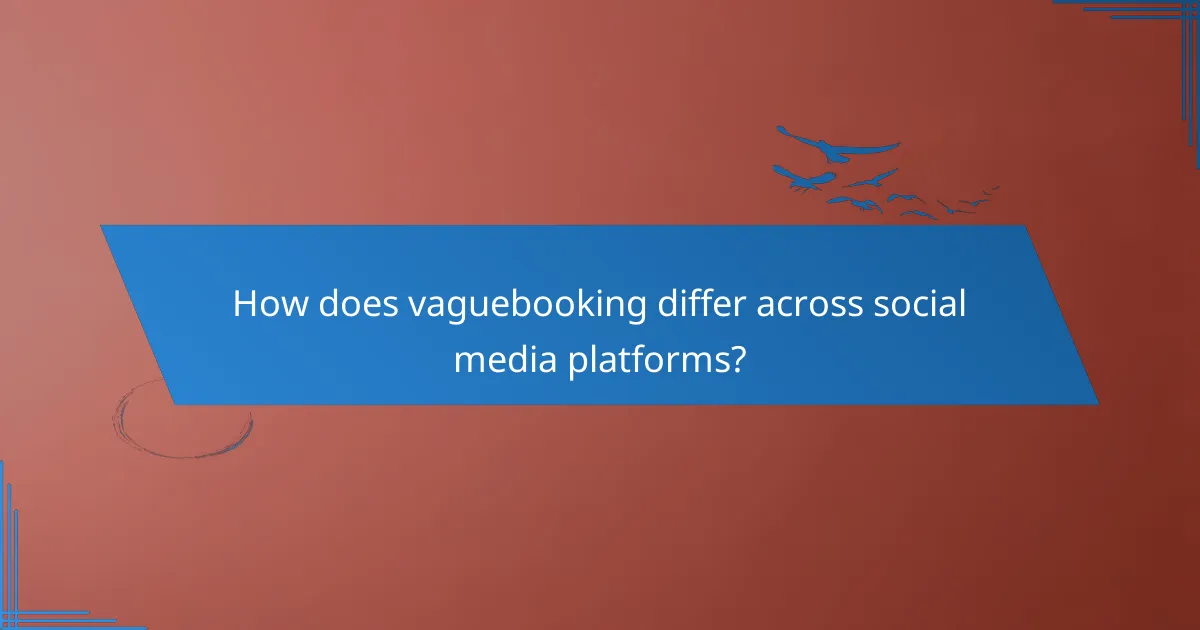
How does vaguebooking differ across social media platforms?
Vaguebooking varies significantly across social media platforms, influenced by user demographics and the nature of each platform. While Facebook often serves as a space for ambiguous emotional expressions, Instagram leans towards visual ambiguity that invites interpretation.
Facebook’s role in vaguebooking trends
On Facebook, vaguebooking typically manifests as cryptic status updates or posts that hint at personal struggles or feelings without providing clear context. This trend allows users to seek attention or sympathy without fully disclosing their issues, often leading to comments that encourage further elaboration.
Common examples include phrases like “Feeling lost” or “Some people just don’t understand,” which prompt friends to inquire about the underlying situation. This behavior can create a cycle of engagement, where users feel compelled to post more vague updates to maintain attention.
Instagram’s visual ambiguity in posts
Instagram’s approach to vaguebooking often involves images that convey emotions or situations without explicit explanations. Users may post a moody landscape, a close-up of a coffee cup, or an abstract image that resonates with their feelings, leaving followers to interpret the meaning.
This visual ambiguity can be powerful, as it encourages engagement through comments and direct messages, prompting discussions about the user’s state of mind. However, it can also lead to misunderstandings, as followers may project their interpretations onto the images without knowing the actual context.
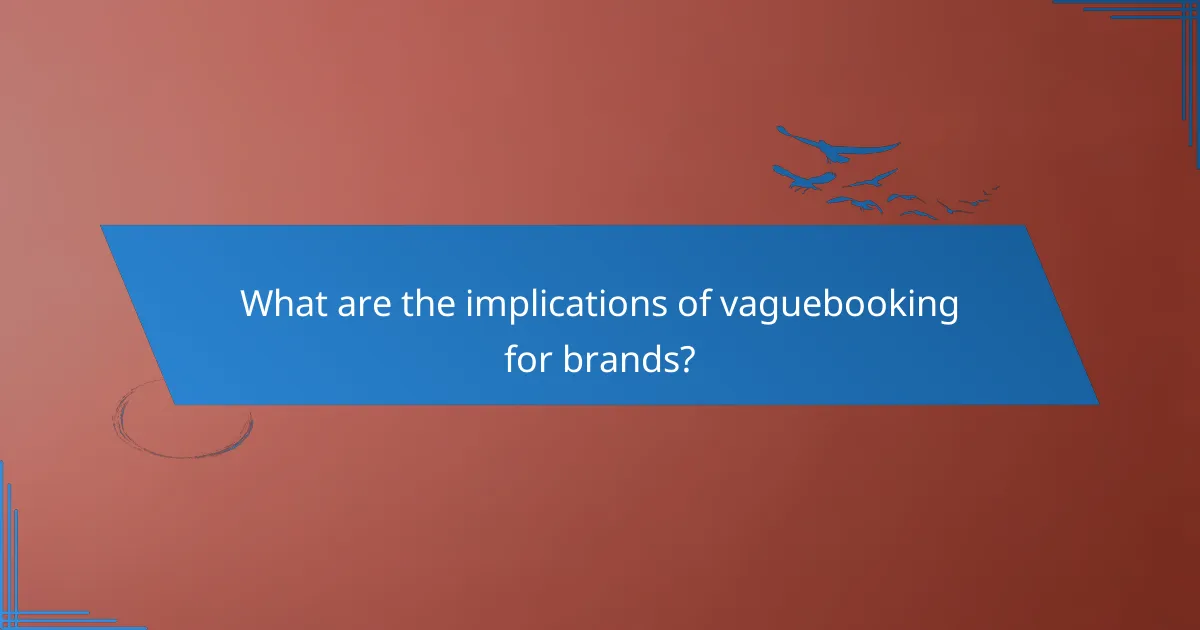
What are the implications of vaguebooking for brands?
Vaguebooking can significantly impact brands by creating ambiguity in messaging, which may confuse consumers. Brands must navigate this trend carefully to maintain clarity while engaging their audience effectively.
Challenges in brand messaging clarity
One of the primary challenges brands face with vaguebooking is the potential for misinterpretation. When messages lack specificity, consumers may draw incorrect conclusions about a brand’s intentions or offerings. This can lead to a disconnect between the brand and its audience, resulting in lost trust.
Additionally, vague messaging can dilute a brand’s identity. Consumers often seek clear and concise communication, and when brands fail to provide this, they risk being overlooked in a crowded marketplace. Brands should strive to balance creativity with clarity to avoid these pitfalls.
Opportunities for engagement through storytelling
Despite the challenges, vaguebooking presents unique opportunities for brands to engage audiences through storytelling. By crafting enigmatic posts that pique curiosity, brands can encourage consumers to interact and seek more information. This can foster a sense of community as followers share their interpretations.
Brands can leverage this trend by creating campaigns that invite user-generated content or responses. For example, asking followers to share their thoughts on a cryptic message can enhance engagement and promote brand loyalty. However, it’s essential to ensure that the underlying message aligns with the brand’s values to maintain authenticity.
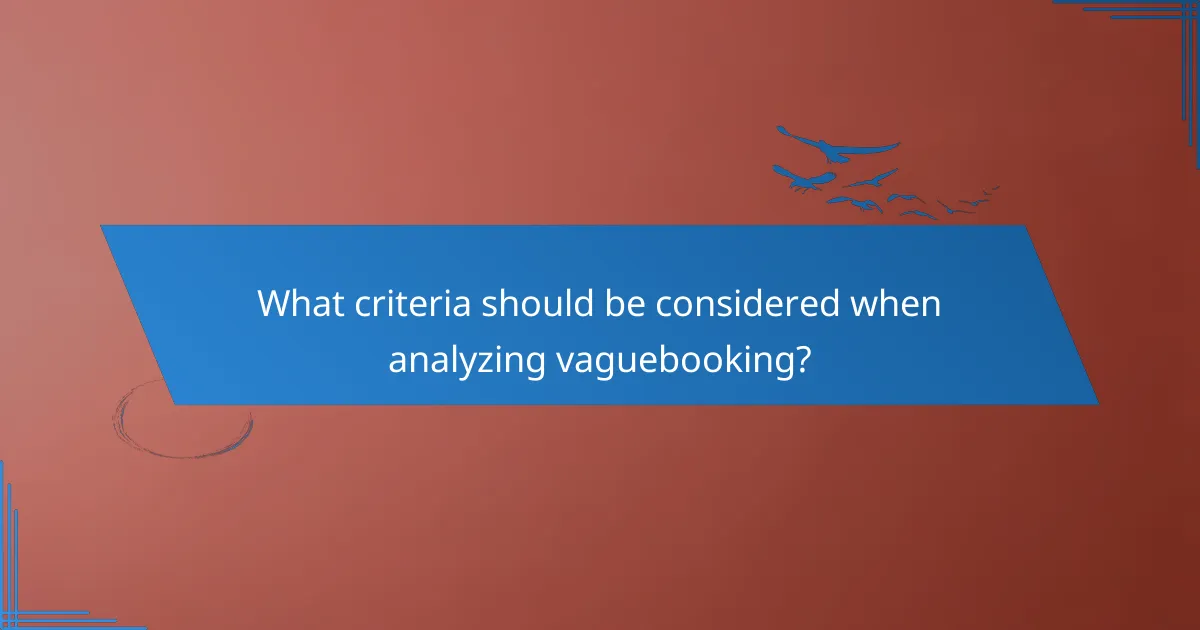
What criteria should be considered when analyzing vaguebooking?
When analyzing vaguebooking, consider the context of the post, the emotional tone, and the audience’s reaction patterns. These elements help to understand the intent behind the vague statements and how they influence social media interactions.
Context of the post
The context of a vaguebooking post includes the circumstances surrounding its creation, such as recent events in the poster’s life or current social issues. For instance, a post made during a public crisis may evoke different interpretations than one shared during a personal milestone.
Additionally, the platform used can affect the context. A post on Facebook might be perceived differently than a tweet on Twitter due to the audience and the nature of the platform. Understanding these nuances is crucial for accurate analysis.
Audience reaction patterns
Audience reactions to vaguebooking often fall into predictable patterns, such as curiosity or concern. Users may comment with questions or supportive messages, seeking clarification or offering empathy. This engagement can amplify the original post’s visibility and impact.
Moreover, the emotional tone of the post can shape reactions. A post that conveys sadness may prompt more supportive responses, while one that appears cryptic might lead to speculation. Recognizing these patterns helps in assessing the effectiveness and reach of vaguebooking strategies.

What future trends are emerging in vaguebooking?
Future trends in vaguebooking are likely to focus on the intersection of social media, mental health, and user engagement. As users become more aware of the implications of their online expressions, vaguebooking may evolve to reflect deeper emotional narratives and community support.
Integration with mental health discussions
Vaguebooking is increasingly intertwined with mental health conversations, as users often share ambiguous posts that hint at personal struggles. This trend can foster a sense of community, allowing individuals to seek support without explicitly detailing their issues.
However, while vaguebooking can raise awareness about mental health, it may also lead to misunderstandings or misinterpretations. Users should consider the potential impact of their posts on their audience and the importance of clarity when discussing sensitive topics.
To effectively integrate mental health discussions into vaguebooking, users can adopt a few strategies: share supportive resources, encourage open dialogue, and be mindful of the emotional tone of their posts. This approach can help create a more constructive online environment while still maintaining an element of mystery.
